This publication is also available online in HTML in print-ready format at www.ic.gc.ca/SMEresearch/reports.
To obtain a copy of this publication or an alternate format [Braille, large print, etc.], please fill out the Publication Request form or contact:
Web Services Centre
Innovation, Science and Economic Development Canada
C.D.Howe Building
235 Queen Street
Ottawa, ON K1A OH5
Canada
Telephone [toll free in Canada]: 1-800-328-6189
Telephone [Ottawa]: 613-954-5031
TTY [for hearing-impaired): 1-866-694-8389
Business hours: 8:30a.m. to 5:00p.m. [Eastern time]
Email:ISED@Canada.ca
Permission to Reproduce
Except as otherwise specifically noted, the information in this publication may be reproduced, in part or in whole and by any means, without charge or further permission from the Department of Industry, provided that due diligence is exercised in ensuring the accuracy of the information reproduced; that the Department of Industry is identified as the source institution; and that the reproduction is not represented as an official version of the information reproduced, or as having been made in affiliation with, or with the endorsement of, the Department of Industry.
For permission to reproduce the information in this publication for commercial purposes, please fill out the Application for Crown Copyright Clearance or contact the Web Services Centre [see contact information above].
© Her Majesty the Queen in Right of Canada,
as represented by the Minister of Industry Canada, 2017
Aussi offert en français sous le titre Contribution des entreprises à forte croissance au changement net d'emploi au Canada, septembre 2017.
Table of Content
Abstract
In this study, for the first time in Canada, the US Bureau of Labor Statistics (BLS) definition for high-growth firms (HGFs) is applied to data from Statistics Canada. Adopting the BLS definition makes findings more meaningful as it covers all firm sizes with 1 employee or more. In comparison, the widely used standard definition for HGFs, developed by the Organisation for Economic Co-operation and Development (OECD), excludes firms with less than 10 employees. Using the OECD's definition for Canada would have excluded about 88 percent of all employer firms.
Producing statistics on HGFs that are inclusive of employer firms of all sizes is becoming increasingly important as policy makers are advancing policies with a focus on identifying HGFs and supporting their growth. This analysis enhances the body of research that is available to policy makers to develop policies that target enterprise growth.
Key findings
This study explores the contribution that HGFs made to net employment change in Canada over the 2009–2012 period by firm age, size, and sector.
Study's definition for HGFs
A firm is considered a HGF if:
- In 2009 it had fewer than 10 employees and grew by 8 or more employees by 2012; or
- In 2009 it had 10 or more employees and grew in the number of employees at an average annualized rate of more than 20 percent between 2009 and 2012.
In 2012, HGFs with 10 or more employees made up 4 percent of all firms with 10 or more employees.
Net employment contribution
- HGFs with 1 to 9 employees made up 0.73 percent of all firms and accounted for 22 percent of the total net employment change over the 2009–2012 period.
- HGFs with 10 or more employees made up 0.51 percent of all firms and accounted for 41 percent of the total net employment change.
- All HGFs combined made up 1.24 percent of all firms and accounted for approximately 63 percent of the total net employment change between 2009 and 2012.
Age
- Thirty-one percent of HGFs were 2 years old or less in 2009; they accounted for 17 percent of the total net employment change.
- Overall, HGFs tended to be young, as about 64 percent were under 10 years old. HGFs under 10 years old accounted for 37 percent of the total net employment change.
Size
- Thirty-five percent of HGFs were micro-enterprises (with 1 to 4 employees). Those firms accounted for 13 percent of the total net employment change between 2009 and 2012.
- Half of HGFs had 5 to 19 employees; they accounted for 21 percent of the total net employment change.
Industry sectors
- Fourteen percent of HGFs were in construction, 11 percent in accommodation and food services, 9 percent in professional, scientific and technical services, and 9 percent in manufacturing.
- Mining, quarrying, and oil and gas extraction, manufacturing, and accommodation and food services had the highest proportions of HGFs, at 4 percent, 3 percent and 3 percent respectively.
- The HGF industry sectors with the highest contribution to the total net employment change were construction (8 percent), professional, scientific and technical services (7 percent), administrative and support, waste management and remediation services (7 percent), accommodation and food services (6 percent), retail trade (6 percent) and manufacturing (6 percent).
1. Introduction
In today's fragile economic environment, job creation is one of the main concerns of governments. Many different measures, including tax deductions and new investments, have been used to support employment and economic growth. In Canada, job creation remains a priority for the federal government, as shown by Budget 2016.Footnote 1 However, job creation policies can be made more efficient by targeting the industries that contribute most to job creation in the Canadian business sector. To identify which firms are most likely to foster employment growth, it is important to have a better understanding of employment business dynamics. Unfortunately, there is little information, mainly because of data unavailability, to assist in determining which types of industries are the largest contributors.
According to Birch (1979, 1981), one of the first economists to study job creation, small firms generated a disproportionately large share of new jobs in the United States in the 1970s (Henrekson and Johansson, 2010). More recently, however, Haltiwanger et al. (2013) showed that after firm age is controlled for, there is no difference between firm size and growth. They found that business start-ups and young businesses play an important role in job creation.
The Organisation for Economic Co-operation and Development (OECD) has created DynEmp, a harmonized dataset for a group of 18 countriesFootnote 2 that contains information on employment at the enterprise level over the 2001–2011 period. With this dataset, the OECD is able to assess employment dynamics and compare results for the various countries. Using DynEmp, Criscuolo et al. (2014) found that young small and medium-sized enterprisesFootnote 3 (SMEs) contributed disproportionately to job creation in each country. On average, young firms accounted for 17 percent of employment but created 42 percent of jobs.
Many other empirical studies show that the major contributors to job creation are a few rapidly growing firms, commonly known as high-growth firms (HGFs) (Henrekson and Johansson, 2010). Furthermore, the fact that a few rapidly growing firms contribute disproportionately to job creation is generally accepted as a stylized fact, since it has been observed in many countries over various periods of time (Coad et al., 2014). However, according to Criscuolo et al. (2014), few studies have examined the role of HGFs in job creation.Footnote 4
For example, Clayton et al. (2013) showed that in 2009, 2 percent of all firms were HGFs, which accounted for 35 percent of all jobs created by expanding firms in the United States over the 2009–2012 period. According to Deschryvere (2008), 5 percent of all firms with 10 or more employees were HGFs and were responsible for 65 percent of all jobs created over the 2003–2006 period in Finland. Anyadike-Danes et al. (2009) observed that HGFs in the United Kingdom contributed 54 percent of new jobs between 2005 and 2008, but made up only 0.61 percent of all firms (6 percent of firms with 10 or more employees). The results for the 2002–2005 period were similar.
There are also some Canadian studies on the subject. Picot and Dupuy (1998) found that job creation was highly concentrated among relatively few fast-growing continuing firmsFootnote 5 in all size groups for consecutive years between 1984 and 1988 (short-term employment change) and over the 1983–1986 period (long-run employment). They used Statistics Canada's Longitudinal Employment Analysis Program (LEAP), which provides information on all companies in the business sector.
Schreyer (2000) obtained similar resultsFootnote 6 for firms in Quebec's manufacturing sector: fast-growing firms accounted for a large share of job creation between 1990 and 1996.
Halabisky et al. (2006) used the LEAP database linked to the Small Area File, known as the "LEAP/SAF", to show that fast-growing continuing firmsFootnote 7 were responsible for a large share of employment creation over the 1985–1999 period. Fast-growing firms accounted for 1 million of the 1.8 million net jobs created between 1985 and 1999. Moreover, by their definition of HGF, those firms made up 7 percent of all private-sector firms in 1985.
Using data from Statistics Canada's LEAP database, Parsley and Halabisky (2008) obtained results consistent with previous studies: fast-growing continuing firms contributed disproportionately to job creation, accounting for 45 percent of net jobs created between 1993 and 2003.Footnote 8
More recently, Dixon and Rollin (2014) also investigated fast-growing firms' contribution to job creation. They found that such firms accounted for a large share of the jobs created in the 2000–2009 period: between 38 percent and 47 percent, depending on the definition of HGF used.Footnote 9 The authors used data from Statistics Canada's LEAP for their analysis.
The main purpose of this analysis is to study net employment change in Canada over the 2009–2012 period. More specifically, HGF contribution to net employment change will be assessed in relation to firm characteristics such as age, size and industry sector.
The major contribution of this paper is to present recent accurate data on the net employment change of rapidly growing firms in Canada, using standard methodology developed by recognized institutions such as the U.S. Bureau of Labor Statistics (BLS) and the OECD.
This paper is organized as follows. Section 2 provides a description of the methodology, definitions, data source and data used in the study. The results are presented in Section 3, and the conclusion in Section 4.
2. Methodology
In this section, we present the definition of HGF used in the paper, and how net employment change is calculated. We also provide details on the data employed to assess the total net employment change of HGFs.
2.1 Defining high-growth firms
There is no consensus on the definition of HGF, which varies widely among researchers. The definition depends on such factors as the growth indicator used, which may include employment or total sales of goods and services, and the measure of growth employed.Footnote 10 Typically, the firms in the top 5 percent or 10 percent of the growth distribution are selected as HGFs. Another method is to set a threshold level and select firms whose growth is above that level as HGFs.
The definition of HGF used in this study is the one proposed by Clayton et al. (2013) in the BLS's Monthly Labor Review. This definition incorporates a threshold in both level and percentage using a "kink point" approach. It can be described as follows:
BLS definition:
- If a firm with fewer than 10 employees at the beginning of the period grows by 8 or more employees over a three-year period, it is classified as a high-growth firm; or
- if a firm with 10 or more employees at the beginning of the period grows at an average annualized rate of more than 20% per year over a three-year period (or 72.8% over the three-year period), it is classified as a high-growth firm.
More specifically, let and denote firm size at t − 3 and t respectively, with and different from zero. The definition means that
- if < 10 and ≥ 8, then the firm is a high-growth firm at t; or
- if ≥ 10 and > 0.20, then the firm is a high-growth firm at t.
It is worth mentioning that the BLS definition of HGF includes the definition adopted by Eurostat–OECD (Eurostat–OECD, 2007). The Eurostat–OECD definition corresponds to the second bullet of the BLS definition and is generally the most accepted methodology for international comparison. However, one major issue with the Eurostat–OECD definition is precisely that it excludes firms that have fewer than 10 employees. For our dataset, this means that approximately 88 percent of firmsFootnote 11 in 2009 will be excluded (Figure 1).
Figure 1: Percentage of firms by size category in 2009
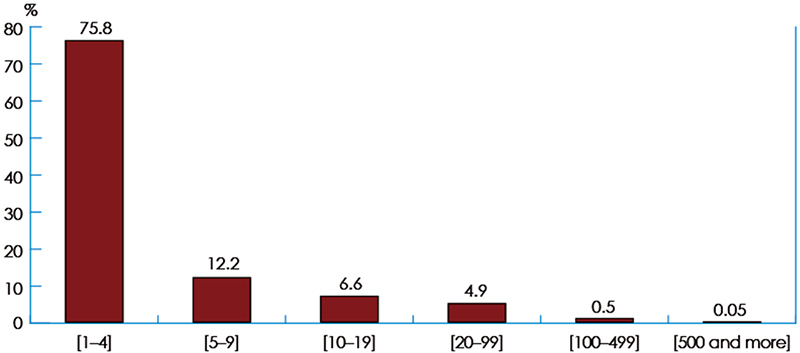
Sources: Statistics Canada, National Accounts Longitudinal Microdata File, 2009–2012; and author's calculations.
The advantage of the BLS definition (and the Eurostat–OECD definition) is that it allows comparison among different countries and across time, as the thresholds for firm growth are fixed.
Another aim of this study is to present HGF results not just for firms with 10 or more employees, as has been the case previously based on the Eurostat–OECD definition, but for all firm sizes. Below we examine the results for HGFs with 1 to 9 employees, HGFs with 10 or more employees, and HGFs with 1 or more employees (i.e., both size categories combined).
2.2 Net employment change
We use a simple method to calculate total net employment change. Let be the total employment at t. The total net employment change between 2009 and 2012, denoted by is calculated as
2.3 Data source
The data source is a new database provided by Statistics Canada, the National Accounts Longitudinal Microdata File (NALMF). It was created by linking multiple administrative files: the Corporation Income Tax Return (T2), Goods and Services Tax (GST), Payroll Account Deductions (PD7), and Statements of Remuneration Paid (T4 slips). These sources were combined through Statistics Canada's Business Register (BR) to produce a final linked file at the enterprise level. Some industry sectors are excluded from the present analysis: utilities, educational services, and public administration (North American Industry Classification System (NAICS) sectors 22, 61 and 91).
Only employer businesses—firms with at least 1 employee—are included in the analysis. Also excluded from the sample are firms likely to be mergers or acquisitions.Footnote 12 In other words, only organic growth is considered in this study.
An important variable in this study is firm age. In what follows, this variable is approximated using the firm's incorporation date recorded in the BR. For firms whose incorporation date is unavailable, the year of entry in the BR is used. In other words, incorporation date and firm entry in the BR are used as proxies to estimate firm age, since no variable indicating actual age, such as establishment date or business registration date, was available. As a consequence, results based on firm age must be interpreted with caution.
3. Results
3.1 Number of firms and net employment change
Table 1 shows the number of HGFs in 2012 in the three 2009 size categories.Footnote 13 The percentage is calculated as the number of HGFs in the size category over the number of firms in the size category and over the total number of firms (with at least 1 employee). HGFs with 10 or more employees made up 4 percent of the firms with 10 or more employees and 0.51 percent of the total firms. Less than 1 percent (0.83 percent) of firms with 1 to 9 employees were HGFs, and HGFs of that size made up only 0.73 percent of all firms. When the two size categories are combined, HGFs accounted for approximatively 1 percent of the total number of firms. In comparison, Clayton et al. (2013) found that HGFs (with at least 1 employee) made up 2 percent of all firms.
| Number of firms | |||
|---|---|---|---|
| [1–9] | [10 and more] | [1 and more] | |
| HGFs | 7,746 | 5,475 | 13,221 |
| Total | 930,897 | 133,023 | 1,063,920 |
| % HGFs in size category | 0.83% | 4.12% | 1.24% |
| % HGFs over total firms | 0.73% | 0.51% | 1.24% |
| Sources: Statistics Canada, National Accounts Longitudinal Microdata File, 2009–2012; and author's calculations. | |||
Net employment change between 2009 and 2012 by 2009 size category is presented in Table 2. The percentage contribution is calculated over the total net employment change, which was 593,188 for the 2009–2012 period. HGFs with 1 to 9 employees contributed 22 percent of the total net employment change, and HGFs with 10 or more employees, 41 percent. Overall, HGFs accounted for 63 percent of the total net employment change between 2009 and 2012.
It is clear from the foregoing that HGFs contribute disproportionately to the total net employment change. This phenomenon is well documented in the literature, as mentioned in Section 1. HGFs with 1 to 9 employees made up 0.73 percent of all firms but contributed 22.3 percent of the total net employment change. Similarly, HGFs with 10 or more employees made up 0.51 percent of all firms and contributed 40.5 percent of the total net employment change. For the two categories combined, HGFs made up only 1.24 percent of all firms but contributed more than 60 percent of the net employment change.
| Net employment change, 2009–2012 | |||
|---|---|---|---|
| [1–9] | [10 and more] | [1 and more] | |
| HGFs | 132,218 | 240,159 | 372,377 |
| Total net employment change | 593,188 | ||
| % HGF contribution | 22.3% | 40.5% | 62.8% |
| Sources: Statistics Canada, National Accounts Longitudinal Microdata File, 2009–2012; and author's calculations. | |||
Table 3 and Table 4 show the total number of firms in 2009 and 2012 and the net employment change between 2009 and 2012, respectively. The termsFootnote 14 used in the tables are defined as follows:
- Births: Firms that have 0 employees or a missing value for employment in 2009 but at least 1 employee in 2012.
- Deaths: Firms that have at least 1 employee in 2009 but 0 employees or a missing value for employment in 2012.
- Continuing firms: Firms that have at least 1 employee in 2009 and in 2012.
| 2009 | 2012 | Net firms change | |
|---|---|---|---|
| Births | 308,260 | 308,260 | |
| Deaths | 262,377 | 262,377 | |
| Continuing firms | 755,660 | 755,660 | |
HGFs [1–9] | 7,746 | ||
HGFs [10 and more] | 5,475 | ||
HGFs [1 and more] | 13,221 | ||
| Total | 1,018,037 | 1,063,920 | 45,883 |
| Sources: Statistics Canada, National Accounts Longitudinal Microdata File, 2009–2012; and author's calculations. | |||
As shown in Table 3, HGFs with 1 to 9 employees and HGFs with 10 or more employees made up 1.0 percent and 0.72 percent of continuing firms respectively in 2012. Overall, HGFs with at least 1 employee made up only 1.7 percent of continuing firms operating in 2009 and 2012.
As shown in Table 4, the total net employment change is equal to the sum of the net employment change of births, deaths and continuing firms.
| 2009 | 2012 | Net employment change | |
|---|---|---|---|
| Births | 813,222 | 813,222 | |
| Deaths | 608,606 | 608,606 | |
| Continuing firms | 6,130,806 | 6,519,379 | 388,572 |
HGFs [1–9] | 33,758 | 165,976 | 132,218 |
HGFs [10 and more] | 163,170 | 403,328 | 240,159 |
HGFs [1 and more] | 196,927 | 569,304 | 372,377 |
| Total | 6,739,419 | 7,332,600 | 593,188 |
| Sources: Statistics Canada, National Accounts Longitudinal Microdata File, 2009–2012; and author's calculations. | |||
3.2 High-growth firms by age
The relationship between HGFs and age has also been explored by many researchers. One stylized fact about HGFs is that they tend to be young [Coad et al. (2014), Henrekson and Johansson (2010), Daunfeldt et al. (2014) and Moreno and Coad (2015)]. Clayton et al. (2013) found that, in the 2009–2012 period, 46.2 percent of HGFs in the United States were 4 years old or less and 33 percent were 2 years old or less. However, a large proportion of HGFs were older, as 34.1 percent were 10 years old or more.
The number and percentage of HGFs in 2012 by 2009 age category are presented in Table 5. HGFs with 1 to 9 employees made up about 2.1 percent of firms in the under-2 category. The percentages of HGFs with 10 or more employees are similar in all age categories, ranging from 0.5 percent to 0.7 percent. HGFs with at least 1 employee made up nearly 3 percent of firms in the under-2 category; this is the highest proportion.
It is worth noting that in OECD terminology,Footnote 15 HGFs with 10 or more employees born 5 years or less before the end of the 3-year observation period are commonly called gazelles. Clearly, this term applies to firms with 10 or more employees that were less than 2 years old in 2009 and underwent rapid growth during the 2009–2012 period. However, we can extend the gazelle concept to include firms with less than 10 employees.
In addition, about 2 percent of firms that were between 3 and 9 years old in 2009 were HGFs with at least 1 employee.
| Number of HGFs | Percentage of HGFs by age category | Total | |||||
|---|---|---|---|---|---|---|---|
| Age in 2009 | [1–9] | [10 and more] | [1 and more] | [1–9] | [10 and more] | [1 and more] | |
| 2 | 3,273 | 773 | 4,046 | 2.1% | 0.5% | 2.6% | 156,671 |
| [3–9] | 2,483 | 1,929 | 4,412 | 0.9% | 0.7% | 1.7% | 262,721 |
| [10–19] | 1,253 | 1,562 | 2,815 | 0.5% | 0.6% | 1.1% | 256,583 |
| 20 | 736 | 1,211 | 1,947 | 0.4% | 0.7% | 1.1% | 184,541 |
| TotalFootnote 16 | 7,746 | 5,475 | 13,221 | 0.72% | 0.51% | 1.24% | 1,063,920 |
| Sources: Statistics Canada, National Accounts Longitudinal Microdata File, 2009–2012; and author's calculations. | |||||||
Figure 2 shows the percentage distribution of HGFs in 2012 by 2009 age category. Gazelles tend to be smaller HGFs, as 42 percent of them have 1 to 9 employees. HGFs with at least 1 employee tend to be younger; 64 percent of them are under 10 years old. In addition, the proportion of HGFs seems to be negatively correlated with age: the proportion of HGFs decreases as age increases.
Figure 2: Distribution of high-growth firms in 2012 by 2009 age category
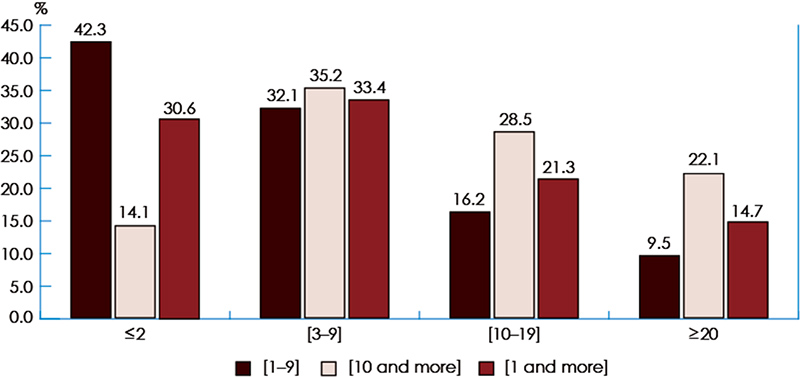
Sources: Statistics Canada, National Accounts Longitudinal Microdata File, 2009–2012; and author's calculations.
Table 6 and Figure 3 show the percentage contribution of HGFs to the total net employment change between 2009 and 2012 by 2009 age category. HGFs with at least 1 employee that were under 10 years old accounted for 37 percent (16.5 percent of HGFs 2 years old or less and 20.9 percent of HGFs between 3 and 9 years old) of the total net employment change between 2009 and 2012.
| Age in 2009 | HGFs | ||
|---|---|---|---|
| [1–9] (%) | [10 and more] (%) | [1 and more] (%) | |
| ≤2 | 10.1 | 6.4 | 16.5 |
| [3–9] | 6.8 | 14.1 | 20.9 |
| [10–19] | 3.4 | 11.8 | 15.2 |
| ≥20 | 1.9 | 8.2 | 10.2 |
| Total | 22.3 | 40.5 | 62.8 |
| Sources: Statistics Canada, National Accounts Longitudinal Microdata File, 2009–2012; and author's calculations. | |||
Figure 3: HGFs' percentage contribution to total net employment change between 2009 and 2012 by 2009 age category
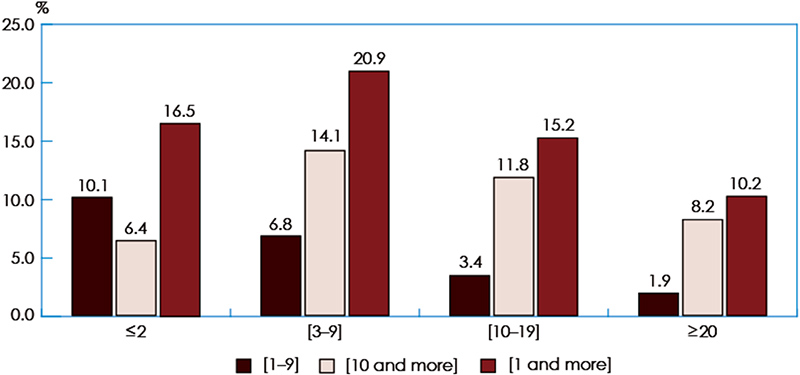
Sources: Statistics Canada, National Accounts Longitudinal Microdata File, 2009–2012; and author's calculations.
3.3 High-growth firms by size
Another characteristic of HGFs that has been explored is firm size. The results concerning the relationship between HGFs and firm size are inconclusive. In general, the results are not considered robust as they depend heavily on the indicator and the measure of growth chosen. Using relative growth tends to overrepresent small firms, and using absolute growth tends to favour large firms, as mentioned by Delmar et al. (2003). However, several empirical studies show that although HGFs tend to be smaller, a non-negligible number of HGFs are large firms (Coad et al., 2014).
The results for HGF contribution by size are also mixed. According to Schreyer (2000), small HGFs have higher net job creation than large firms. However, large HGFs contribute significantly to job creation. Deschryvere (2008) noted that medium-sized firms contributed the most to job creation, accounting for 26 percent of the total employment added by all HGFs over the 2003–2006 period. Clayton et al. (2013) found that HGFs with fewer than 10 employees contributed 20 percent of the employment growth attributable to HGFs between 2009 and 2012. However, employment creation by large HGFs (with 500 or more employees) accounted for 16.8 percent of the total employment by HGFs.
In this section, we consider firm size at the beginning of the period (2009). Table 7 shows the number and percentage of HGFs in 2012 by firm size in 2009. Note that the percentages are based on the 755,660 firms that satisfied the definition of HGF in 2012 and whose 2009 firm size is known. The remaining 308,260 firms may be new firms that were not operating before 2012 or whose 2009 size data are missing. In our terminology, the former are referred to as continuing firms, and the latter as deaths.
| Number of HGFs | Percentage of HGFs by firm size | Total | |||
|---|---|---|---|---|---|
| Firm size in 2009 | [1–9] | [10 and more] | [1 and more] | ||
| [1–4] | 4,608 | 4,608 | 0.9% | 529,221 | |
| [5–9] | 3,138 | 3,138 | 2.8% | 110,714 | |
| [10–19] | 3,256 | 3,256 | 5.2% | 62,372 | |
| [20–99] | 2,035 | 2,035 | 4.3% | 47,447 | |
| [100–499] | 171 | 171 | 3.1% | 5,443 | |
| [500 and more] | 13 | 13 | 2.8% | 463 | |
| TotalFootnote 17 | 7,746 | 5,475 | 13,221 | 1.24% | 1,063,920 |
| Sources: Statistics Canada, National Accounts Longitudinal Microdata File, 2009–2012; and author's calculations. | |||||
The 10-to-19 size category had the highest proportion of HGFs in 2012, with 5.2 percent, followed by the 20-to-99 category, with 4.3 percent. The smallest share of HGFs was in the 1-to-4 category.
Figure 4 shows that 35 percent of HGFs with at least 1 employee were micro-enterprises, i.e., firms with between 1 and 4 employees. However, nearly half of HGFs had between 5 and 19 employees. Clayton et al. (2013) reported similar results for HGFs in the United States over the 2009–2012 period. The size category with the fewest HGFs is the 500-or-more category, with only 0.01 percent of all HGFs that have at least 1 employee.
Figure 4: Percentage distribution of HGFs (at least 1 employee) in 2012 by 2009 firm size category
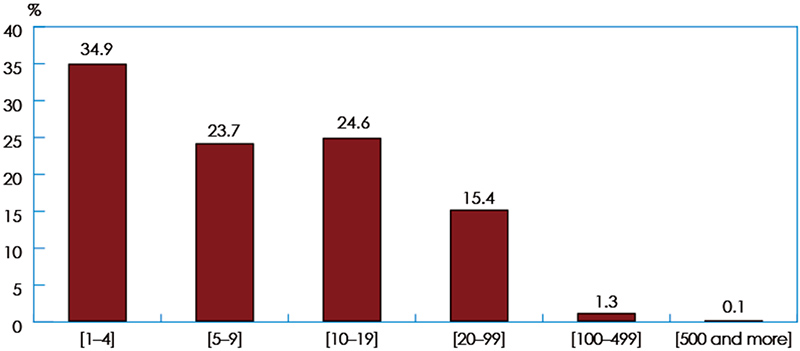
Sources: Statistics Canada, National Accounts Longitudinal Microdata File, 2009–2012; and author's calculations.
Also of interest is HGFs' contribution to net employment change between 2009 and 2012 by 2009 firm size (Table 8). For HGFs with at least 1 employee, the 20-to-99 category was the largest contributor, accounting for 19 percent of the total net employment change (Figure 5). Micro-enterprise HGFs (with 1 to 4 employees) contributed 13 percent of the total net employment change. On the other hand, more than one-third of the net total employment change came from HGFs with 1 to 19 employees.
| Size in 2009 | HGFs | ||
|---|---|---|---|
| [1–9] | [10 and more] | [1 and more] | |
| [1–4] | 79,543 | 79,543 | |
| [5–9] | 52,676 | 52,676 | |
| [10–19] | 68,918 | 68,918 | |
| [20–99] | 110,051 | 110,051 | |
| [100–499] | 41,939 | 41,939 | |
| [500 and more] | 19,250 | 19,250 | |
| Total | 132,218 | 240,159 | 372,377 |
| Sources: Statistics Canada, National Accounts Longitudinal Microdata File, 2009–2012; and author's calculations. | |||
Figure 5: HGFs' percentage contribution to total net employment change in 2012 by 2009 firm size
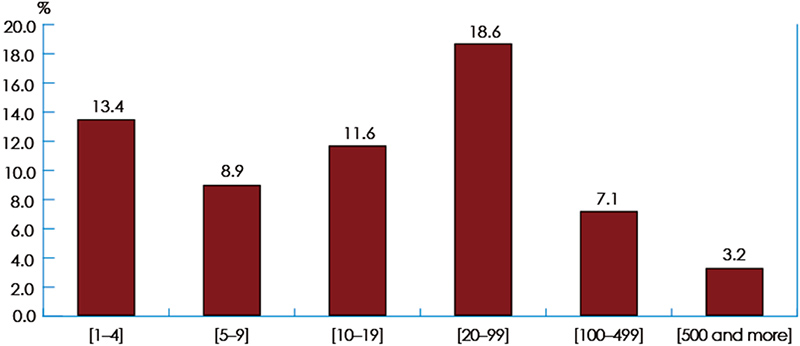
Sources: Statistics Canada, National Accounts Longitudinal Microdata File, 2009–2012; and author's calculations.
3.4 High-growth firms by industry sector
Many authors have associated high growth with firms in the high-technology sector. However, empirical studies have painted quite a different picture, showing that HGFs are present in all industry sectors (Coad et al., 2014). For example, Clayton et al. (2013) found that 46.2 percent of HGFs in the United States were in the following sectors: construction; professional, scientific and technical services; health care and social assistance; and accommodation and food services. The results obtained using the NALMF indicate that Canada also has HGFs in all industry sectors.
Table 9 shows the number of HGFs by NAICS industry sector in 2012. However, some firms could not be classified as the information was not available in the NALMF (13 percent of all firms in 2012). Data are also provided for a special grouping, information and communications technology (ICT), which includes certain industry groups (4-digit NAICS level) in manufacturing; wholesale trade; information and cultural industries; professional, scientific and technical services; and other services.
| Industry sector | Number of HGFs | Percentage of HGFs | Total number of firms | ||||
|---|---|---|---|---|---|---|---|
| [1–9] | [10 and more] | [1 and more] | [1–9] | [10 and more] | [1 and more] | ||
| Agriculture, forestry, fishing and hunting | 224 | 109 | 333 | 0.5% | 0.2% | 0.7% | 48,596 |
| Mining, quarrying, and oil and gas extraction | 160 | 137 | 297 | 2.0% | 1.7% | 3.7% | 7,961 |
| Construction | 1,012 | 847 | 1,859 | 0.8% | 0.7% | 1.5% | 120,640 |
| Manufacturing | 476 | 682 | 1,158 | 1.2% | 1.7% | 2.8% | 40,912 |
| Wholesale trade | 399 | 366 | 765 | 0.9% | 0.9% | 1.8% | 42,906 |
| Retail trade | 681 | 462 | 1,143 | 0.8% | 0.5% | 1.3% | 89,687 |
| Transportation and warehousing | 402 | 273 | 675 | 0.9% | 0.6% | 1.4% | 46,717 |
| Information and cultural industries | 119 | 94 | 213 | 1.0% | 0.8% | 1.9% | 11,337 |
| Finance and insurance | 118 | 101 | 219 | 0.5% | 0.4% | 0.9% | 25,203 |
| Real estate and rental and leasing | 232 | 114 | 346 | 0.5% | 0.2% | 0.8% | 46,001 |
| Professional, scientific and technical services | 693 | 487 | 1,180 | 0.6% | 0.4% | 1.0% | 122,309 |
| Management of companies and enterprises | 64 | 40 | 104 | 0.7% | 0.4% | 1.1% | 9,798 |
| Administrative and support, waste management and remediation services | 517 | 451 | 968 | 1.2% | 1.0% | 2.2% | 44,132 |
| Health care and social assistance | 494 | 347 | 841 | 0.6% | 0.4% | 1.0% | 80,569 |
| Arts, entertainment and recreation | 139 | 99 | 238 | 0.9% | 0.6% | 1.5% | 15,931 |
| Accommodation and food services | 944 | 552 | 1,496 | 1.6% | 0.9% | 2.5% | 60,271 |
| Other services | 507 | 275 | 782 | 0.5% | 0.2% | 0.7% | 110,140 |
| TotalFootnote 18 | 7,746 | 5,475 | 13,221 | 0.72% | 0.51% | 1.24% | 1,063,920 |
| ICTFootnote 19 | 267 | 257 | 524 | 0.8% | 0.8% | 1.6% | 32,053 |
| Sources: Statistics Canada, National Accounts Longitudinal Microdata File, 2009–2012; and author's calculations. | |||||||
Figure 6 shows that HGFs with 1 to 9 employees were mainly in four industry sectors: construction (13.1 percent), accommodation and food services (12.2 percent), professional, scientific and technical services (8.9 percent) and retail trade (8.8 percent). Among HGFs with 10 or more employees, 15.5 percent were in construction, 12.5 percent in manufacturing, 10.1 percent in accommodation and food services, and 8.9 percent in professional, scientific and technical services. Overall, HGFs with at least 1 employee were mostly in construction (14.1 percent), accommodation and food services (11.3 percent), professional, scientific and technical services (8.9 percent), manufacturing (8.8 percent) and retail trade (8.6 percent). Moreover, the high-technology sector did not have a preponderance of HGFs, as only 4 percent of HGFs were in ICT.
Figure 6: Percentage distribution of HGFs by industry sector, 2012
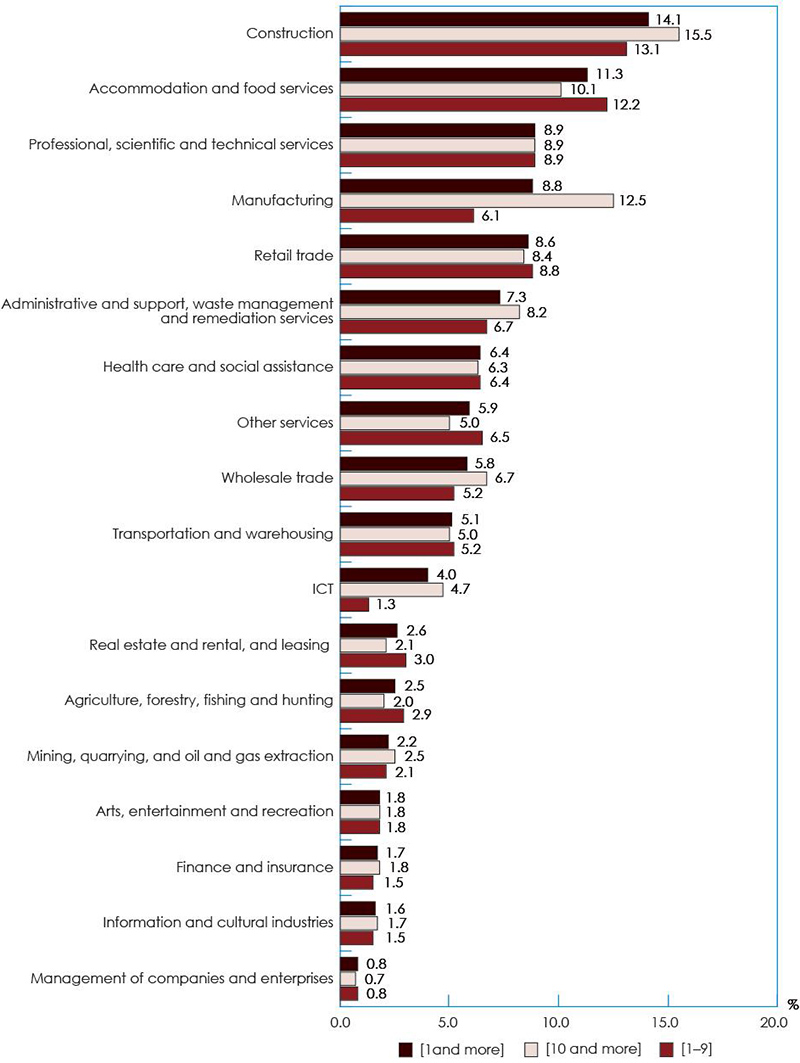
Sources: Statistics Canada, National Accounts Longitudinal Microdata File, 2009–2012; and author's calculations.
It is also worth examining the percentage of HGFs in industry sectors in 2012 (Table 9 and Figure 7). This provides another perspective on the data and paints a completely different picture from the percentage distribution of HGFs by industry sector (shown in Figure 6). Mining, quarrying, and oil and gas extraction had the highest percentage of HGFs for all three size categories, with 2.0 percent, 1.7 percent and 3.7 percent for HGFs with 1 to 9 employees, 10 or more employees and at least 1 employee, respectively. In the 10-or-more-employees category, HGFs also made up 1.7 percent of all firms in the manufacturing sector.
For HGFs with 1 to 9 employees, the industry sectors with the second- and third-highest proportions of HGFs were accommodation and food services (1.6 percent) and manufacturing (1.2 percent) and administrative and support, waste management and remediation services (1.2 percent).
For HGFs with 10 or more employees, administrative and support, waste management and remediation services (1.0 percent) ranked second, and accommodation and food services (0.9 percent) and wholesale trade (0.9 percent) tied for third.
For HGFs with at least 1 employee, manufacturing had the second-highest proportion, at 2.8 percent, and accommodation and food services came third, with 2.5 percent.
Next, we consider the HGF net employment change by industry sector between 2009 and 2012 (Table 10). The table shows that for several industry sectors, the total net employment change was lower than the HGFs' net employment change. For example, arts, entertainment and recreation had a net employment change of -28, but HGFs with at least 1 employee had a net employment gain of 5,821.
Table 11 shows the HGFs' percentage contribution to total net employment change between 2009 and 2012 by industry sector. HGFs with 1 to 9 employees in accommodation and food services had the highest contribution to the total net employment change for the 2009–2012 period, at 3.1 percent. The next highest contributions were in construction (2.7 percent), retail trade (2.1 percent) and professional, scientific and technical services (1.9 percent). Similarly, HGFs with 10 or more employees in construction had the highest contribution to the total net employment change over the 2009–2012 period, at 5.4 percent. Administrative and support, waste management and remediation services and manufacturing contributed 4.8 percent of the total net employment change, followed by professional, scientific and technical services, at 4.7 percent.
Figure 7: Percentage of HGFs in industry sectors, 2012

Sources: Statistics Canada, National Accounts Longitudinal Microdata File, 2009–2012; and author's calculations.
| Industry sector | HGFs | Total | ||
|---|---|---|---|---|
| [1–9] | [10 and more] | [1 and more] | ||
| Agriculture, forestry, fishing and hunting | 5,157 | 3,662 | 8,820 | 10,219 |
| Mining, quarrying, and oil and gas extraction | 2,870 | 7,892 | 10,762 | 16,549 |
| Construction | 15,934 | 32,126 | 48,060 | 54,293 |
| Manufacturing | 7,690 | 28,216 | 35,906 | 37,887 |
| Wholesale trade | 5,868 | 13,146 | 19,014 | 18,251 |
| Retail trade | 12,390 | 24,750 | 37,140 | 27,177 |
| Transportation and warehousing | 6,143 | 8,328 | 14,471 | 17,258 |
| Information and cultural industries | 2,586 | 6,555 | 9,140 | 9,041 |
| Finance and insurance | 2,637 | 8,483 | 11,120 | 4,061 |
| Real estate and rental and leasing | 4,212 | 3,293 | 7,506 | 5,285 |
| Professional, scientific and technical services | 11,006 | 27,861 | 38,867 | 42,465 |
| Management of companies and enterprises | 1,046 | 1,652 | 2,698 | -954 |
| Administrative and support, waste management and remediation services | 10,131 | 28,644 | 38,775 | 33,441 |
| Health care and social assistance | 8,037 | 12,022 | 20,059 | 41,852 |
| Arts, entertainment and recreation | 2,681 | 3,140 | 5,821 | -28 |
| Accommodation and food services | 18,190 | 19,634 | 37,824 | 46,583 |
| Other services | 7,401 | 9,558 | 16,960 | 11 |
| TotalFootnote 20 | 132,218 | 240,159 | 372,377 | 593,188 |
| ICT | 4,842 | 11,727 | 16,570 | 18,487 |
| Sources: Statistics Canada, National Accounts Longitudinal Microdata File, 2009–2012; and author's calculations. | ||||
For HGFs with at least 1 employee, six industry sectors accounted for approximately 40 percent of the total net employment change over the 2009–2012 period (Figure 8): construction (8.1 percent), professional, scientific and technical services (6.6 percent), administrative and support, waste management and remediation services (6.5 percent), accommodation and food services (6.4 percent), retail trade (6.3 percent) and manufacturing (6.1 percent). In comparison, according to Clayton et al. (2013), 52 percent of all jobs created by HGFs between 2009 and 2012 were in professional, scientific and technical services; administrative and support, waste management and remediation services; health care and social assistance; and manufacturing.
| Industry sector | HGFs | Total (%) | ||
|---|---|---|---|---|
| [1–9] (%) | [10 and more] (%) | [1 and more] (%) | ||
| Agriculture, forestry, fishing and hunting | 0.9 | 0.6 | 1.5 | 1.7 |
| Mining, quarrying, and oil and gas extraction | 0.5 | 1.3 | 1.8 | 2.8 |
| Construction | 2.7 | 5.4 | 8.1 | 9.2 |
| Manufacturing | 1.3 | 4.8 | 6.1 | 6.4 |
| Wholesale trade | 1.0 | 2.2 | 3.2 | 3.1 |
| Retail trade | 2.1 | 4.2 | 6.3 | 4.6 |
| Transportation and warehousing | 1.0 | 1.4 | 2.4 | 2.9 |
| Information and cultural industries | 0.4 | 1.1 | 1.5 | 1.5 |
| Finance and insurance | 0.4 | 1.4 | 1.9 | 0.7 |
| Real estate and rental and leasing | 0.7 | 0.6 | 1.3 | 0.9 |
| Professional, scientific and technical services | 1.9 | 4.7 | 6.6 | 7.2 |
| Management of companies and enterprises | 0.2 | 0.3 | 0.5 | -0.2 |
| Administrative and support, waste management and remediation services | 1.7 | 4.8 | 6.5 | 5.6 |
| Health care and social assistance | 1.4 | 2.0 | 3.4 | 7.1 |
| Arts, entertainment and recreation | 0.5 | 0.5 | 1.0 | −0.005 |
| Accommodation and food services | 3.1 | 3.3 | 6.4 | 7.9 |
| Other services | 1.2 | 1.6 | 2.9 | 0.002 |
| TotalFootnote 21 | 22.3 | 40.5 | 62.8 | 100 |
| ICT | 0.8 | 2.0 | 2.8 | 3.1 |
| Sources: Statistics Canada, National Accounts Longitudinal Microdata File, 2009–2012; and author's calculations. | ||||
Figure 8: HGFs' contribution to total net employment change between 2009 and 2012 by industry sector
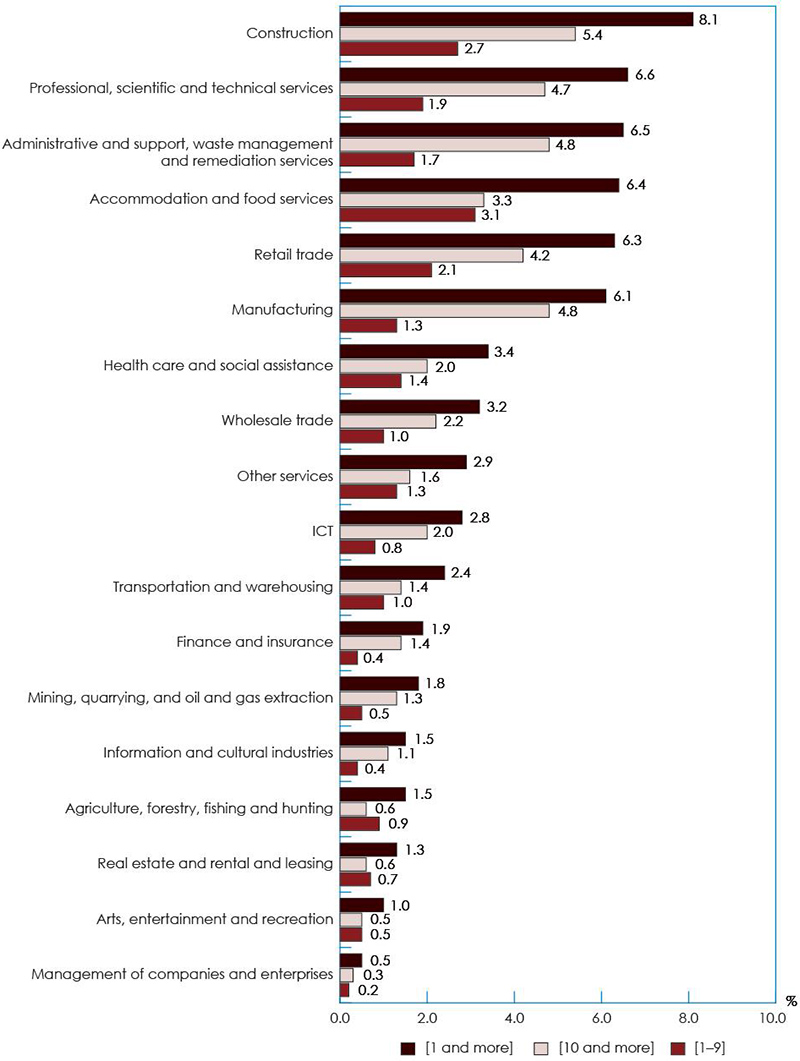
Sources: Statistics Canada, National Accounts Longitudinal Microdata File, 2009–2012; and author's calculations.
It is also possible to calculate each industry sector's contribution to HGF net employment change between 2009 and 2012 (Table 12 and Figure 9).
| Industry sector | [1–9] | [10 and more] | [1 and more] |
|---|---|---|---|
| (%) | (%) | (%) | |
| Agriculture, forestry, fishing and hunting | 3.9 | 1.5 | 2.4 |
| Mining, quarrying, and oil and gas extraction | 2.2 | 3.3 | 2.9 |
| Construction | 12.1 | 13.4 | 12.9 |
| Manufacturing | 5.8 | 11.8 | 9.6 |
| Wholesale trade | 4.4 | 5.5 | 5.1 |
| Retail trade | 9.4 | 10.3 | 10.0 |
| Transportation and warehousing | 4.6 | 3.5 | 3.9 |
| Information and cultural industries | 2.0 | 2.7 | 2.5 |
| Finance and insurance | 2.0 | 3.5 | 3.0 |
| Real estate and rental and leasing | 3.2 | 1.4 | 2.0 |
| Professional, scientific and technical services | 8.3 | 11.6 | 10.4 |
| Management of companies and enterprises | 0.8 | 0.7 | 0.7 |
| Administrative and support, waste management and remediation services | 7.7 | 11.9 | 10.4 |
| Health care and social assistance | 6.1 | 5.0 | 5.4 |
| Arts, entertainment and recreation | 2.0 | 1.3 | 1.6 |
| Accommodation and food services | 13.8 | 8.2 | 10.2 |
| Other services | 5.6 | 4.0 | 4.6 |
| TotalFootnote 22 | 100 | 100 | 100 |
| ICT | 3.7 | 4.9 | 4.4 |
| Sources: Statistics Canada, National Accounts Longitudinal Microdata File, 2009–2012; and author's calculations. | |||
For HGFs with 1 to 9 employees, we observe that accommodation and food services contributed 13.8 percent of the net employment change, followed by construction (12.1 percent) and retail trade (9.4 percent). For HGFs with 10 or more employees, the industry sectors that contributed the most were construction (13.4 percent), administrative and support, waste management and remediation services (11.9 percent) and manufacturing (11.8 percent).
Figure 9: Industry sector contribution to HGF net employment change between 2009 and 2012
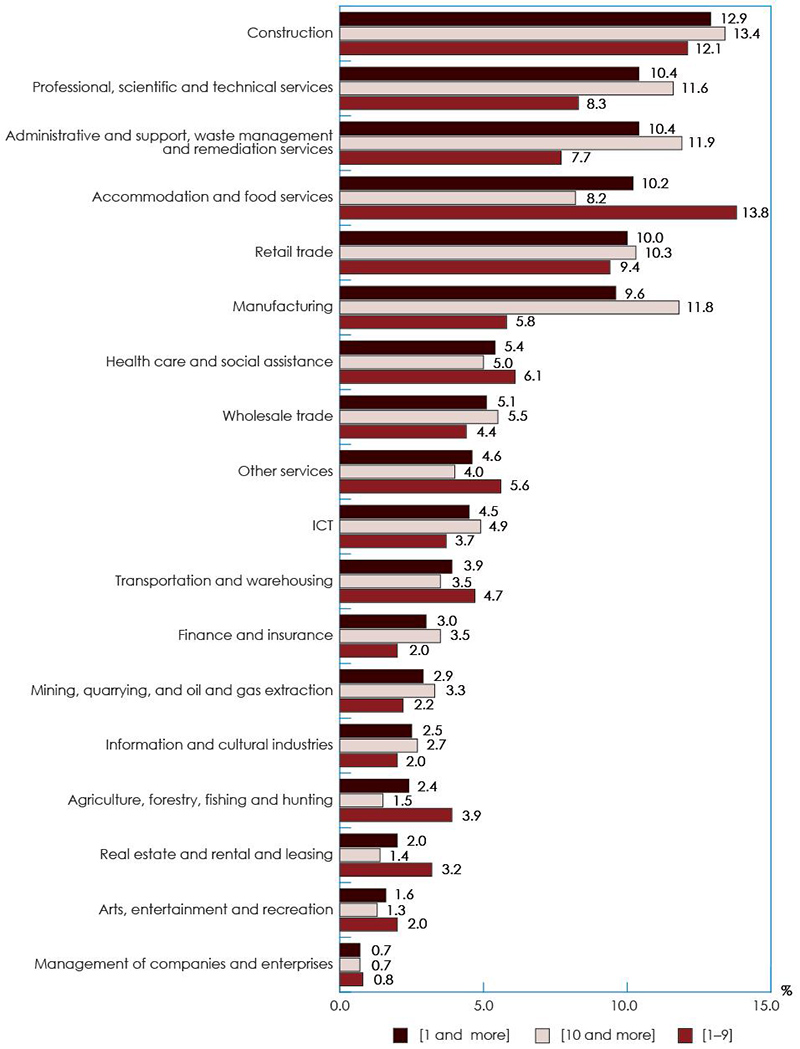
Sources: Statistics Canada, National Accounts Longitudinal Microdata File, 2009–2012; and author's calculations.
The industry sectors that contributed the most to the net employment change for HGFs with at least 1 employee were construction (12.9 percent), professional, scientific and technical services (10.4 percent), administrative and support, waste management and remediation services (10.4 percent), accommodation and food services (10.2 percent), retail trade (10.0 percent) and manufacturing (9.6 percent). Those sectors accounted for 64 percent of the net employment change for HGFs with at least 1 employee.
4. Conclusion
The main purpose of this paper was to present accurate data on the total net employment change for high-growth firms (HGFs) in Canada over the 2009–2012 period in relation to dimensions such as firm age, firm size and industry sector. The dataset used in this analysis was from a new database provided by Statistics Canada, the National Accounts Longitudinal Microdata File (NALMF).
This report shows that HGFs made a disproportionate contribution to the total net employment change between 2009 and 2012. They were responsible for 63 percent of the total net employment change, but made up only 1 percent of firms with at least one employee. This result is entirely consistent with the findings of other empirical studies in the literature.
HGFs tended to be young, as 64 percent of them were under 10 years old; HGFs under 10 years old accounted for 37 percent of the total net employment change. It was also observed that HGFs were relatively small. Thirty-five percent of HGFs had between one and four employees. Those micro-enterprises accounted for 13 percent of the total net employment change over the 2009–2012 period.
Furthermore, 43 percent of HGFs were in the following industry sectors: construction; accommodation and food services; professional, scientific and technical services; and manufacturing. Therefore, HGFs were not concentrated in the high-technology sector. In fact, only 4 percent of HGFs in Canada were in the information and communications technology sector. This phenomenon has also been noted in other studies.
The HGF industry sectors with the highest contribution to the total net employment change were construction (8 percent), professional, scientific and technical services (7 percent), administrative and support, waste management and remediation services (7 percent), accommodation and food services (6 percent), retail trade (6 percent) and manufacturing (6 percent).
References
- Anyadike-Danes, Michael, K. Bonner, M. Hart and C. Mason (2009). "Measuring Business Growth: High-growth firms and their contribution to employment in the UK."National Endowment for Science, Technology and the Arts.
- Birch, David (1979). The Job Generation Process. Cambridge: MIT Program on Neighborhood and Regional Change.
- Birch, David (1981)." Who creates jobs?" The public interest, 65, 3–14.
- Clayton, Richard, A. Sadeghi, J. R. Spletzer and D. M. Talan (2013). "High-employment-growth firms: defining and counting them." Monthly Labor Review, June 2013, U.S. Bureau of Labor Statistics.
- Coad, Alex., S.-O. Daunfeldt, W. Hölz, D. Johansson and P. Nightingale (2014). "High-growth firms: introduction to the special section." Industrial and Corporate Change, 23(1), 91–112.
- Criscuolo, Chiara, P. N. Gal and C. Menon (2014). "The Dynamics of Employment Growth: New Evidence from 18 Countries." OECD Science, Technology and Industry Policy Papers, No.14. Paris: OECD Publishing.
- Daunfeldt, Sven-Olov, N. Eler, and D. Johansson (2014). "The economic contribution of high-growth firms: do policy implications depend on the choice of growth indicator?" Journal of Industry, Competition and Trade, 14(3), 337–365.
- Delmar, Frédéric, P. Davidsson and W. B. Gartner (2003). "Arriving at the high-growth firm." Journal of business venturing, 18(2), 189–2016.
- Deschryvere, Matthias (2008). "High growth firms and job creation in Finland." Research Institute of the Finnish Economy.
- Dixon, Jay and A.-M. Rollin (2014). "The Distribution of Employment Growth Rates in Canada: The Role of High-growth and Rapidly Shrinking Firms." Ottawa: Statistics Canada, Economic Analysis Division.
- Eurostat–OECD (2007). Manual on Business Demography Statistics. Paris: OECD.
- Halabisky, David, E. Dreessen and C. Parsley (2006). "Growth in firms in Canada, 1985–1999." Journal of Small Business & Entrepreneurship, 19(3), 255–267.
- Haltiwanger, John, R. S. Jarmin and J. Miranda (2013). "Who creates jobs? Small versus large versus young." Review of Economics and Statistics, 95(2), 347–361.
- Henrekson, Magnus and D. Johansson (2010). "Gazelles as job creators: a survey and interpretation of the evidence." Small Business Economics, 35(2), 227–244.
- Moreno, Fabiana and A. Coad (2015). "High-Growth Firms: Stylized Facts and Conflicting Results." Science Policy Research Unit Working Paper Series.
- Organisation for Economic Co-operation and Development (2012). Entrepreneurship at a Glance 2012. Paris: OECD Publishing.
- Parsley, Chris and D. Halabisky(2008). "Profile of growth firms: A summary of Industry Canada research." Ottawa: Industry Canada.
- Picot, Garnett and R. Dupuy (1998). "Job creation by company size class: The magnitude, concentration and persistence of job gains and losses in Canada." Small Business Economics, 10(2), 117–139.
- Schreyer, Paul (2000). "High-growth firms and employment." OECD Science, Technology and Industry Working Papers, No. 2000/03. Paris: OECD Publishing.

